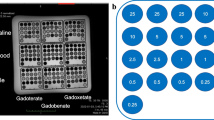Abstract
To evaluate whether clips from prior cholecystectomy impair image quality during magnetic resonance cholangiography (MRC) at 3 Tesla (T) compared with 1.5 T, surgical clips were embedded in a gel phantom and positioned at predefined distances from a fluid-filled tube designed to simulate the bile duct. The maximum clip distance was noted where susceptibility artifacts obscured the fluid-filled tube at 1.5 T and 3 T. Susceptibility artifact size was calculated for each sequence within each magnet class. In vivo analysis included 42 patients postcholecystectomy who underwent MRC at either 1.5 T or 3 T. In vitro, mean area of susceptibility artifacts was 104 mm2 on 3-T and 75 mm2 on 1.5-T MR imaging (MRI). While surgical clips within a 2-mm range impaired visualization of the fluid-filled tube on 1.5-T MRI, this range increased to 4 mm on 3-T MRI. In vivo, MRC image quality was impaired by susceptibility artifacts in three of 21 cases at 3 T and in two of 21 cases at 1.5 T. Overall, biliary pseudo-obstructions due to susceptibility artifacts from cholecystectomy surgical clips were not substantially more common on 3-T MRC in clinical practice, and patients with a history of prior cholecystectomy should not be excluded from a 3-T MRC.





Similar content being viewed by others
References
Barish MA, Yucel EK, Ferrucci JT (1999) Magnetic resonance cholangiopancreatography. N Engl J Med 341:258–264
Merkle EM, Haugan PA, Thomas J, Jaffe TA, Gullotto C (2006) MR Cholangiography: 3.0 Tesla versus 1.5 Tesla - a pilot study. AJR Am J Roentgenol 186:516–521
Schick F (2005) Whole-body MRI at high field: technical limits and clinical potential. Eur Radiol 15:946–959
Lewin JS, Duerk JL, Jain VR, Petersilge CA, Chao CP, Haaga JR (1996) Needle localization in MR-guided biopsy and aspiration: effects of field strength, sequence design, and magnetic field orientation. Am J Roentgenol 166:1337–1345
Frahm C, Gehl HB, Melchert UH, Weiss HD (1996) Visualization of magnetic resonance-compatible needles at 1.5 and 0.2 Tesla. Cardiovasc Intervent Radiol 19:335–340
Allkemper T, Schwindt W, Maintz D, Heindel W, Tombach B (2004) Sensitivity of T2-weighted FSE sequences towards physiological iron depositions in normal brains at 1.5 and 3.0 T. Eur Radiol 14:1000–1004
Merkle EM, Nelson RC (2006) Double gradient echo techniques for liver MRI: beyond in-phase and opposed-phase imaging. Radiographics, (in press)
Butts K, Pauly JM, Daniel BL, Kee S, Norbash AM (1999) Management of biopsy needle artifacts: techniques for RF-refocused MRI. J Magn Reson Imaging 9:586–595
Petersilge CA, Lewin JS, Duerk JL, Yoo JU, Ghaneyem AJ (1996) Optimizing imaging parameters for MR evaluation of the spine with titanium pedicle screws. AJR Am J Roentgenol 166:1213–1218
Port JD, Pomper MG (2000) Quantification and minimization of magnetic susceptibility artifacts on GRE images. J Comput Assist Tomogr 24:958–964
Lauer UA, Graf H, Berger A, Claussen CD, Schick F (2005) Radio frequency versus susceptibility effects of small conductive implants - a systematic MRI study on aneurysm clips at 1.5 and 3 T. Magn Reson Imaging 23:563–569
Graf H, Lauer UA, Berger A, Schick F (2005) RF artifacts caused by metallic implants or instruments which get more prominent at 3 T: an in vitro study. Magn Reson Imaging 23:439–493
Kramer SC, Wall A, Maintz D, Bachmann R, Kugel H, Heindel W (2004) 3.0 Tesla magnetic resonance angiography of endovascular aortic stent grafts: phantom measurements in comparison with 1.5 Tesla. Invest Radiol 39:413–417
Weishaupt D, Quick HH, Nanz D, Schmidt M, Cassina PC, Debatin JF (2000) Ligating clips for three-dimensional MR angiography at 1.5 T: in vitro evaluation. Radiology 214:902–907
Watanabe Y, Dohke M, Ishimori et al (1999) Diagnostic pitfalls of MR cholangiopancreatography in the evaluation of the biliary tract and gallbladder. Radiographics 19:415–429
Irie H, Honda H, Kuroiwa T et al (2001) Pitfalls in MR cholangiopancreatographic interpretation. Radiographics 21:23–37
Van Hoe L, Mermuys K, Vanhoenacker P (2004) MRCP pitfalls. Abdom Imaging 29:360–387
Author information
Authors and Affiliations
Corresponding author
Rights and permissions
About this article
Cite this article
Merkle, E.M., Dale, B.M., Thomas, J. et al. MR liver imaging and cholangiography in the presence of surgical metallic clips at 1.5 and 3 Tesla. Eur Radiol 16, 2309–2316 (2006). https://doi.org/10.1007/s00330-006-0234-1
Received:
Revised:
Accepted:
Published:
Issue Date:
DOI: https://doi.org/10.1007/s00330-006-0234-1




